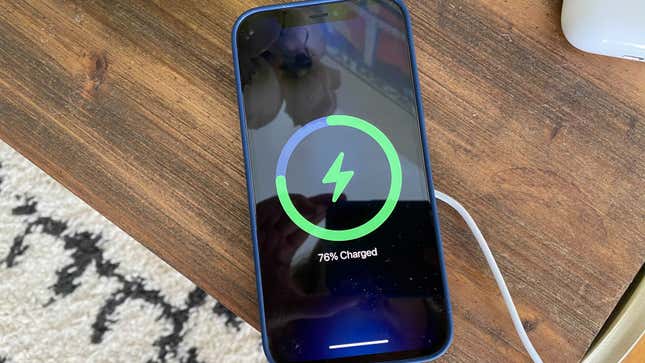
Even with its new A14 chip, Ceramic Shield screen, and revamped design, Apple’s new MagSafe for iPhone charging might be the iPhone 12's most important new feature because it solves the most annoying thing about traditional wireless chargers. The MagSafe charger for iPhones appears to be a major innovation, but it’s also created a few new challenges in its wake.
Currently, the biggest issue with wireless chargers is that they don’t really work if you want to use your phone and charge it at the same time—it’s sort of an either/or proposition. Technically, you could squeeze your phone and wireless charging pad together like a weird gadget sandwich in order to hold the phone upright while charging wirelessly, but let’s be honest, that’s incredibly awkward!
When you factor in the size and weight of a lot of wireless chargers, trying to do so is more trouble than it’s worth, and while some wireless chargers do come with cradles that allow the phone to sit upright while charging, that position isn’t really suited for anything more than a quick glance to see recent notifications or a short text. So that means if you’re low on juice but still want to watch a video or play a game while lying in bed, you’re going to have to plug in.
By building magnets into its new MagSafe for iPhone system, Apple has not only removed the difficulty of lining up a phone with the sweet spot on a wireless charging pad, but it’s also created a simple and easy to way to wirelessly charge a phone regardless of how you hold it. It’s a very elegant improvement for an existing piece of tech (which is what Apple is really best at), and by increasing MagSafe for iPhone’s wireless charging speeds up to 15 watts (up from 7.5 watts on the iPhone 11), the iPhone 12 and (and presumably future iPhones) are also getting wireless charging speeds more in line with other flagship devices.
Furthermore, while Apple hasn’t said anything yet, it feels like a forgone conclusion that MagSafe for iPhone will be a critical feature in creating a completely portless iPhone. It might not happen next year or even the year after that, but following concepts like the Meizu Zero and the Vivo Apex 2019, it’s clear the industry is moving towards a future where phones have no ports at all— whether we like it or not.
In the meantime, as clever as a solution as MagSafe for iPhone is, Apple’s new wireless charging tech has also created a handful of awkward interactions that seem kind of counter to what we expect from the company. The first is that while MagSafe for iPhone is backward compatible with older iPhones and other Qi wireless compatible devices at large, the small diameter of the MagSafe for iPhone charging disc will almost certainly make charging an iPhone 11 or other phones that don’t have magnets in their backs more difficult, not less. At that point, it might actually be easier to put an iPhone 11 face down on a flat surface and then rest the MagSafe for iPhone disc on the phone’s back, though that would come with the downside of not being able to see the phone’s screen while it’s charging.

Then there’s the small issue of the MagSafe for iPhone requiring a USB-C brick. Because Apple isn’t tossing in a power brick alongside the purchase of a new iPhone 12 or the MagSafe cable, millions of people upgrading from older devices are going to have to buy a new brick anyways, which adds a small and annoying cost to the MagSafe Charger’s $40 listed price.
But the most confounding thing about MagSafe for iPhone is that it’s limited to phones (and AirPods) in the first place. Why not make the new MagSafe charging work with other Apple products too?
Apple just released the new Apple Watch Series 6 and Apple Watch SE less than a month ago, and while both watches (and other older Apple Watches) support wireless charging via a magnetic cradle, according to Apple’s specs the MagSafe Charger is not compatible with the Apple Watch. That means if you travel, you’ll have to bring two separate wireless chargers to power up your iPhone and Apple Watch, which seems kind of silly and somewhat wasteful, especially considering Apple made a big point about trying to reduce e-waste during the iPhone 12's keynote presentation.
And while 15 watts of power is a bit low to support something like an iPad Pro, if Apple has created a MagSafe Charger that you plug into a USB-C cable, rather than have the cable be hard-wired, it’d be a cinch to remove disk and plug in a USB-C cord to charge a phone then switch the cable over to the iPad or other USB-C device as needed. Instead, now you need to carry more wires around to support iPads.
Hopefully, in the future, Apple can increase the MagSafe Charger’s power output to support a wider range of devices, because right now, MagSafe feels like a strange bit of anti-synergy within Apple’s own ecosystem.
I don’t want it to seem like I am completely down on Apple’s new charging system. MagSafe for iPhone is a smart way to improve wireless charging, which is tech that more companies and people are starting to embrace due to its convenience and ease of use. I’d even call wireless charging essential for any tech-obsessed nerds trying to simplify their lives, and I expect that over the next 12 months, a bunch of Apple’s competitors will come out with copycat solutions for their own products. Still, with a just a few simple tweaks, Apple’s MagSafe Charging could be even better.